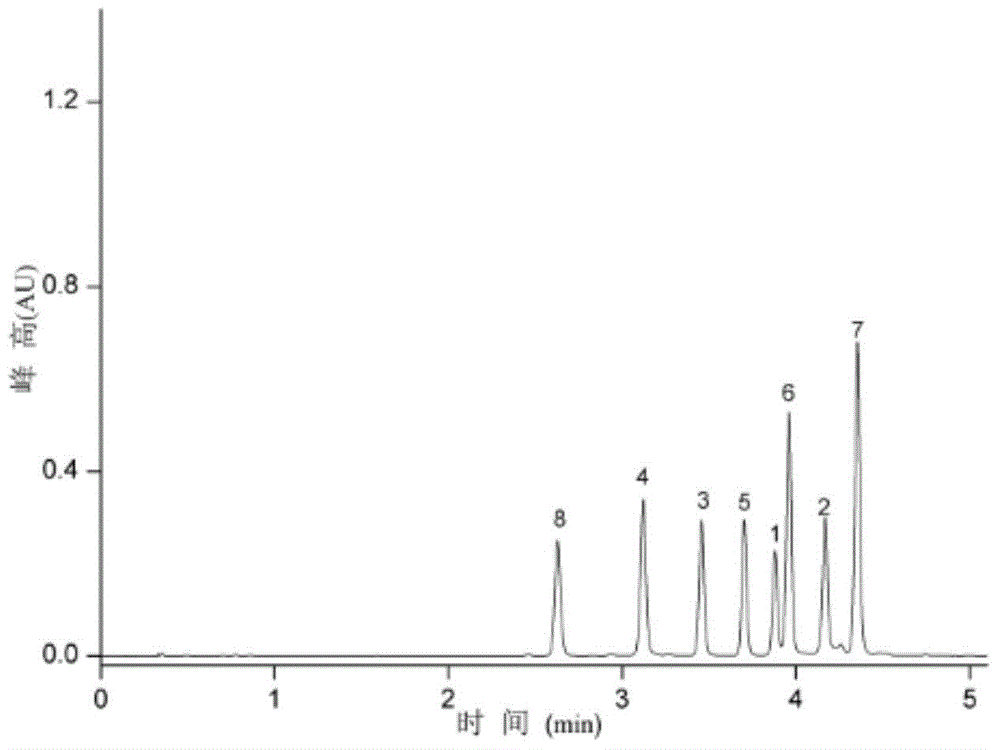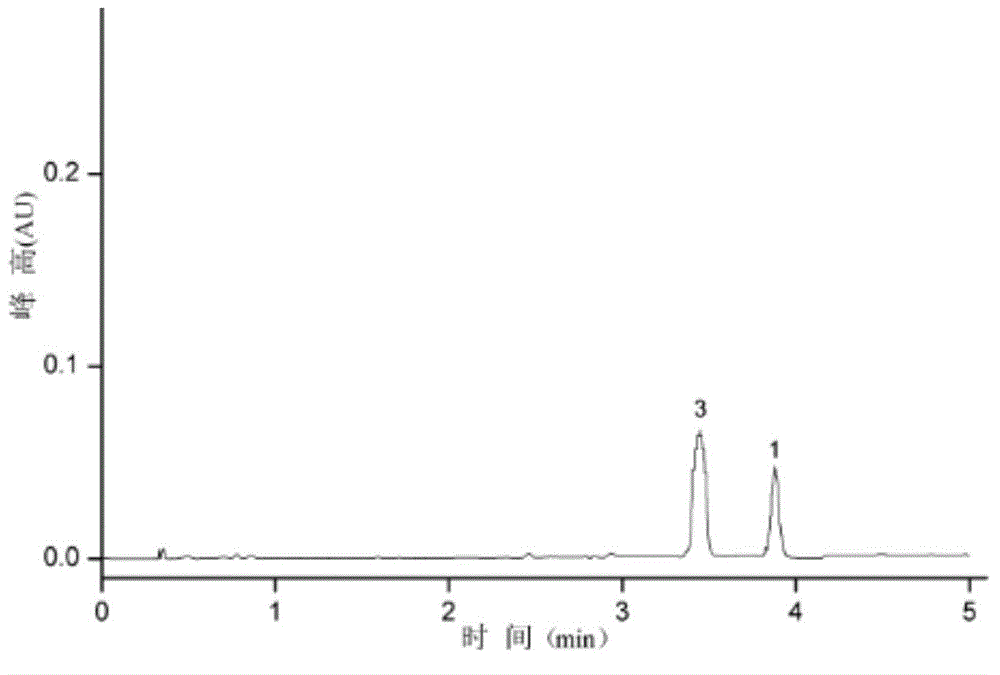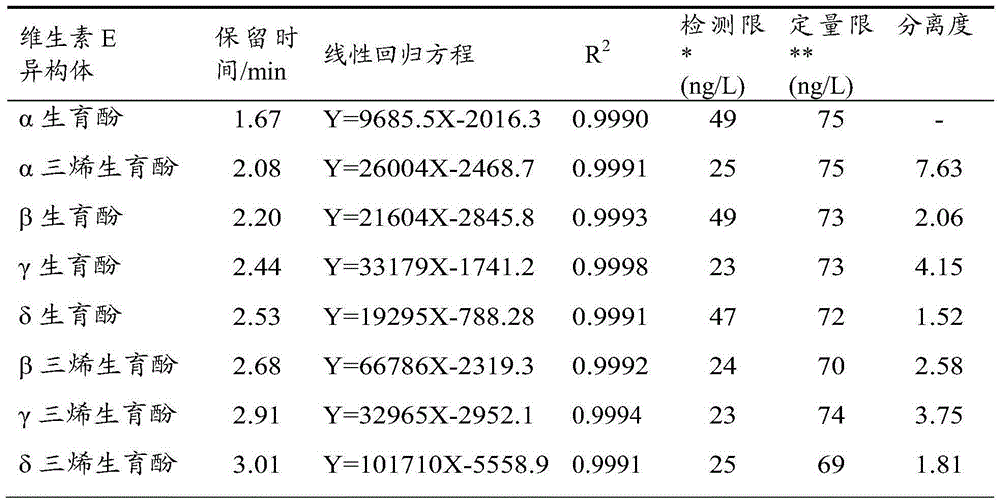Method for measuring content of vitamin E in food with ultra-performance convergence chromatography
An ultra-efficient phase combination and vitamin technology, applied in measuring devices, instruments, scientific instruments, etc., can solve the problems of low resolution, large amount of organic solvents, and long analysis time, achieving high resolution and low amount of organic solvents , the effect of improving the extraction rate
- Summary
- Abstract
- Description
- Claims
- Application Information
AI Technical Summary
Problems solved by technology
Method used
Image
Examples
Embodiment 1
[0044] A method for the determination of vitamin E content in food by ultra-high performance convergence chromatography:
[0045] 1. Extraction:
[0046] Take fresh papaya, beat quickly, vacuum freeze-dry in the dark for 12 hours, and then grind quickly. Accurately weigh 12.0g powdery sample into a 150mL brown saponification bottle, add 30mL ethanol, 5mL vitamin C (10%, ie 0.1g / mL) and 10mL potassium hydroxide (50%, ie 0.5g / mL) solution in turn, boiling water Reflux saponification in the bath for 30min, shake once every 8-10min.
[0047] The solution after saponification was cooled to room temperature, and 85 mL of ether was added for extraction operation. After sealing, the solution was shaken vigorously for 2 min. The extract was washed with ultrapure water until the eluate was not alkaline, the lower aqueous phase was discarded, an appropriate amount of anhydrous sodium sulfate was added for drying, filtered with double-layer filter paper, and then distilled under reduced...
Embodiment 2
[0073] A method for the determination of vitamin E content in food by ultra-high performance convergence chromatography:
[0074] 1. Extraction:
[0075] Take 2.0g tea tree oil, put it in a 150mL brown saponification bottle, add 27.5mL ethanol, 5mL vitamin C (10%, ie 0.1-0.2g / mL) and 9mL potassium hydroxide (50%, ie 0.5g / mL) solution in turn , Reflux saponification in boiling water bath for 30min, shake every 8-10min.
[0076] The solution after saponification was cooled to room temperature, and 85 mL of ether was added for extraction operation. After sealing, the solution was shaken vigorously for 2 min. The extract was washed with ultrapure water until the eluate was not alkaline, the lower aqueous phase was discarded, an appropriate amount of anhydrous sodium sulfate was added for drying, filtered with double-layer filter paper, and then distilled under reduced pressure in a water bath at 50°C and recovery of ether. The extract was fully dissolved in 2.0 mL of ethanol, c...
Embodiment 3
[0085] A method for the determination of vitamin E content in food by ultra-high performance convergence chromatography:
[0086] 1. Extraction:
[0087] Fresh Moringa leaves were taken, vacuum freeze-dried in the dark for 12 hours, and then quickly ground. Accurately weigh 12.0g powdery sample into a 150mL brown saponification bottle, add 30mL ethanol, 5mL vitamin C (20%, ie 0.2g / mL) and 10mL potassium hydroxide (60%, ie 0.6g / mL) solution in turn, boiling water Reflux saponification in the bath for 30min, shake once every 8-10min.
[0088] The solution after saponification was cooled to room temperature, and 85 mL of ether was added for extraction operation. After sealing, the solution was shaken vigorously for 2 min. The extract was washed with ultrapure water until the eluate was not alkaline, the lower aqueous phase was discarded, an appropriate amount of anhydrous sodium sulfate was added for drying, filtered with double-layer filter paper, and then distilled under redu...
PUM
| Property | Measurement | Unit |
|---|---|---|
| Diameter | aaaaa | aaaaa |
| Column length | aaaaa | aaaaa |
| Particle size | aaaaa | aaaaa |
Abstract
Description
Claims
Application Information
 Login to View More
Login to View More - R&D
- Intellectual Property
- Life Sciences
- Materials
- Tech Scout
- Unparalleled Data Quality
- Higher Quality Content
- 60% Fewer Hallucinations
Browse by: Latest US Patents, China's latest patents, Technical Efficacy Thesaurus, Application Domain, Technology Topic, Popular Technical Reports.
© 2025 PatSnap. All rights reserved.Legal|Privacy policy|Modern Slavery Act Transparency Statement|Sitemap|About US| Contact US: help@patsnap.com



